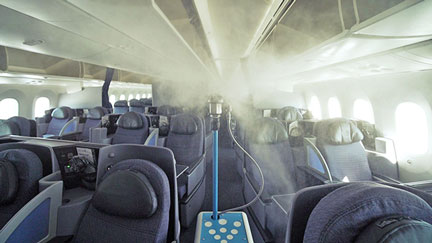Study: Flying United Airlines is safe from COVID-19 exposure

A Zoono Microbe Shield, an antimicrobial sanitizing procedure that forms a lasting bond with surfaces and inhibits the growth of microbes, sprays an antimicrobial coating inside a United Airlines plane cabin. This procedure serves as an added layer of protection that complements the airline’s existing, electrostatic spraying regimen. (United Airlines)
A landmark study on “Safety of Commercial Air Travel” that was recently released by the U.S. Department of Defense through its U.S. Transportation Command, or U.S. Transcom, has concluded that a United Airlines cabin during a flight is one of the safest enclosed environments in the world and that the risk of COVID-19 exposure on a United aircraft is “virtually non-existent.”
The results of the study, which was shared with the media on behalf of Koji Nagata, United Airlines director for Asia/Pacific Communications, said that the U.S. Transcom study was conducted aboard a Boeing 777 and 767 United Airlines aircraft using “Particulate Testing Methodology.” It determined that fast onboard air recirculation, downward designed air ventilation and efficient HEPA filters, which are designed to arrest very fine particles, make the cabin of a United airplane one of the safest indoor environments in the world.
The study also stated that it was the most comprehensive study on cabin airflow done to date and demonstrates that when a passenger is seated and wearing a mask, on average only 0.003% of infected air particles could enter their breathing zone, even when every seat on the plane is occupied. The findings also showed that even in neighboring seats, risk is limited and that masks continue to help minimize exposure when someone coughs.
The study, which took place over six months, comprised 300 tests conducted over 38 hours of flight time and 45 hours of ground testing on United aircraft. Each test released 180 million particles—equivalent to the number of particles that would be produced by thousands of coughs.
The study was done by releasing particles across the entire cabin by section, using a mannequin equipped with an integrated aerosol generator to simulate breathing and coughing with a mask and without. Each section had 42 bio-defense sensors set up in every seat across multiple rows. Sensors were also placed in the galleys and jetbridge during ground testing. The sensors represented other passengers who could potentially come in contact with the particles emitted. To make the situation even more realistic, thermal blankets were used to simulate body heat emission onboard.
Approximately 99.99% of particles were filtered out of the cabin within six minutes due to fast air circulation, downward air ventilation and efficient filtration systems on the plane.
Aside from U.S. Transcom, the Defense Advanced Research Projects Agency was also involved in the study. They were joined by other study participants such as Boeing, S3i, Zeteo Tech, and the National Strategic Research Institute at the University of Nebraska.
According to UA chief customer officer Toby Enqvist, these results from the U.S. Department of Defense demonstrate “that the steps we have taken at United, including maximizing air flow, running our air filtration system at all times, enforcing a mandatory mask policy and overhauling our cleaning procedures mean your chances of COVID-exposure on a United aircraft are nearly non-existent, even if your flight is full.”























